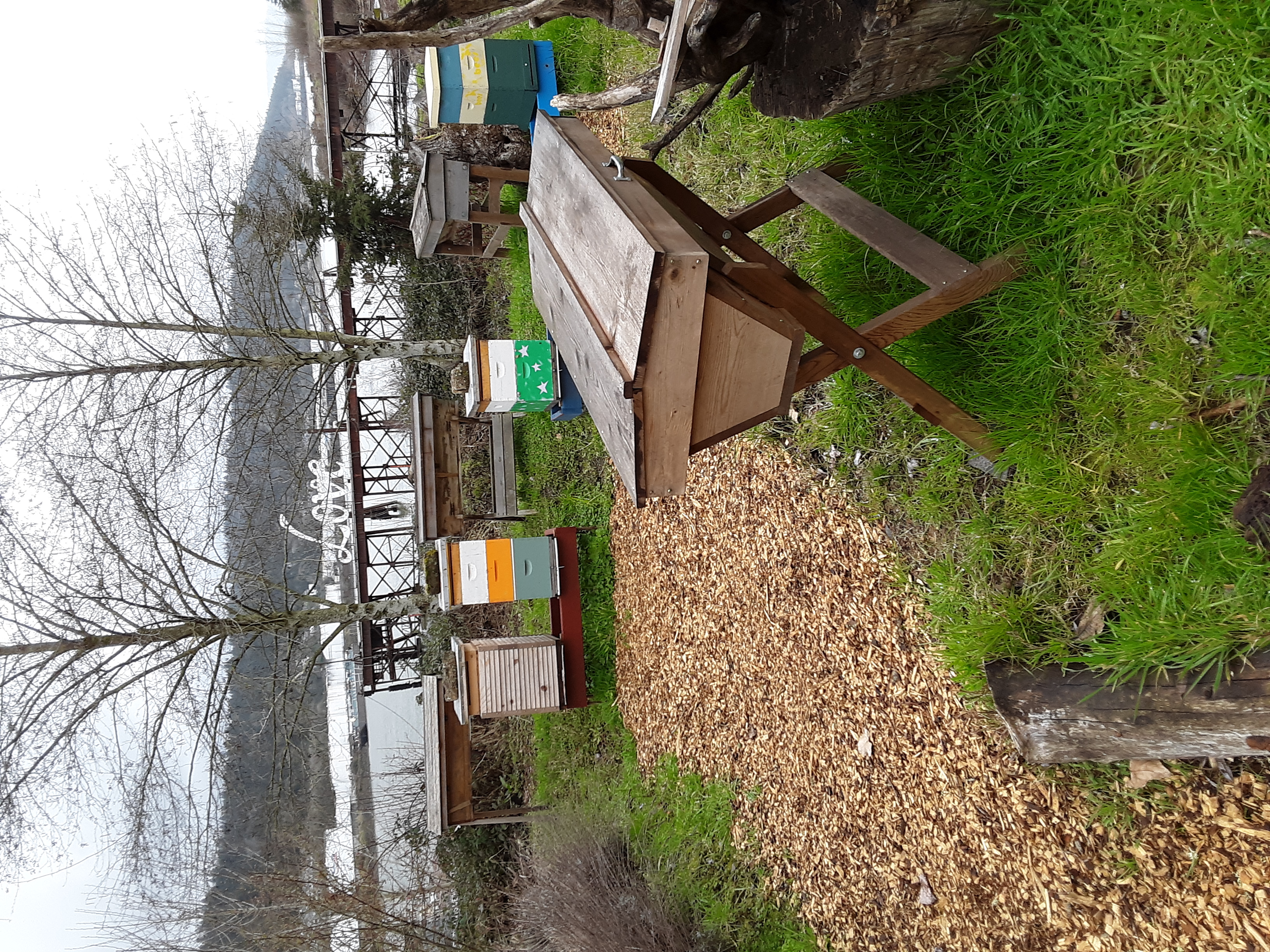Beeswax comb that interferes with normal colony inspection such as comb built outside frame outlines, extra comb in boxes not completely filled with frames, comb built between boxes on top of bottom bars, beneath covers, or comb constructed in feeders, spacers, or extra pieces of equipment.
Honey bees precisely space parallel combs; bee space is 3/8 inch. The Langstroth hive insures bee space through the use of frames. Natural comb and comb constructed in a non-standard hive (such as the top bar hive), or in cavities by feral beesferal bees:
a wild, non-managed nest of honey bees, as in a tree
, may not remain in a single parallel orientation. Narrow spaces (less than 3/8 inch) are closed by bees with propolis, while larger spaces are filled with either deeper comb cells (for example those filled with honey) or by adding additional beeswax comb in the extra space.
Bees will frequently construct comb between boxes (burr combburr comb:
comb built between frames, between boxes, or in spaces where the bee space is not maintained. Often used to rear drones, as a ladder to go to another hive box, or to fill in space that is greater than bee space._Caron.jpg) ) or to brace parallel comb. Such comb cells might include drone brood or have honey stores. If such combs interfere with colony inspection, they should be removed. Some beekeepers scrape top bars to remove such extra comb at each inspection. Too much scraping may lead to stings and defensive bees due to the continued disturbance. A rule of thumb: if the comb doesn’t interfere with colony inspection leave it as the bees built it.
) or to brace parallel comb. Such comb cells might include drone brood or have honey stores. If such combs interfere with colony inspection, they should be removed. Some beekeepers scrape top bars to remove such extra comb at each inspection. Too much scraping may lead to stings and defensive bees due to the continued disturbance. A rule of thumb: if the comb doesn’t interfere with colony inspection leave it as the bees built it.
A strong nectar flow stimulates bees to build comb. Too little space to store incoming nectar is also a strong impetus to build comb. Too little empty comb in honey supers may lead to extra comb between frames, between boxes, or in empty spaces within the hive that can interfere with colony manipulations (see also Supering).
If bees construct comb outside of frame outline or to fill in extra space it needs be removed and bee space restored to maintain the removable frame condition. When wood foundation or plastic foundation frames are used, bees will sometimes build comb perpendicular to the desired comb arrangement. This comb must be cut out. When foundationless frames are used, the bees may not align their combs with the top bars, leading to cross comb. And top bar hives may frequently have such misaligned cross comb constructed. In both instances cross combs should be removed and parallel removable comb condition restored.
Combs lacking a single parallel orientation (cross comb) can make colony inspection more time consuming and difficult. Neglecting or forgetting to completely fill hive boxes with the correct number of frames is a common beekeeper error. Such “extra” comb needs to be removed and the space re-filled with frames containing drawn comb or foundation.
Keeping bees in hives with non-removable frames or unframed combs is illegal in some states, where removable combs are required for proper disease inspection by apiaryapiary:
a place where beehives and beekeeping equipment are located; also called a bee yard. An out-apiary is a site away from the owner’s residence. inspectors. Ordinary hive managements are complicated by extra comb or comb in boxes without moveable frames.
inspectors. Ordinary hive managements are complicated by extra comb or comb in boxes without moveable frames.
Extra comb built due to strong nectar flow represents the best time to draw new frames of foundation. The new comb at the top bar, termed whiting, is a signal that additional super space may be needed to hold the incoming nectar.
As comb is used, especially to rear brood, it darkens; it is recommended to replace dark comb with new frames of foundation (frequently after 4-5 years when used to rear brood). Frames in honey supers do not darken as rapidly and are not as frequently replaced. For the best drawn comb, foundation should be drawn when there is a strong nectar flow (normally in late spring) after the bee colony has built from the lowest winter population.
If extra comb is removed or burr combburr comb:
comb built between frames, between boxes, or in spaces where the bee space is not maintained. Often used to rear drones, as a ladder to go to another hive box, or to fill in space that is greater than bee space._Caron.jpg) between boxes removed, do not discard on the ground as this may lead to pests like skunks; instead you can gather the removed pieces and use them to make beeswax products.
between boxes removed, do not discard on the ground as this may lead to pests like skunks; instead you can gather the removed pieces and use them to make beeswax products.
burr comb, natural comb. non-parallel drawn comb (cross comb), improper bee space
Blackiston H. 2021. Measure for the 'Bee Space' in Your Beehive. For Dummies. Accessed 2023. https://www.dummies.com/article/home-auto-hobbies/hobby-farming/beekeeping/measure-for-the-bee-space-in-your-beehive-170795
Borst P. 2015. Taking Measure of Bee Space. American Bee Journal 155(8): 869-872. https://bluetoad.com/publication/?i=264842&p=45&view=issueViewer and https://bluetoad.com/publication/?m=5417&i=264842&view=articleBrowser&article_id=2051666&ver=html5
Connor LJ. 2015. Beeswax. American Bee Journal. Accessed 2023. https://americanbeejournal.com/beeswax/
Carter A. n.d. What is Burr Comb and How to Control it? Beekeeping Insider. Accessed 2023. https://beekeepinginsider.com/what-is-burr-comb/